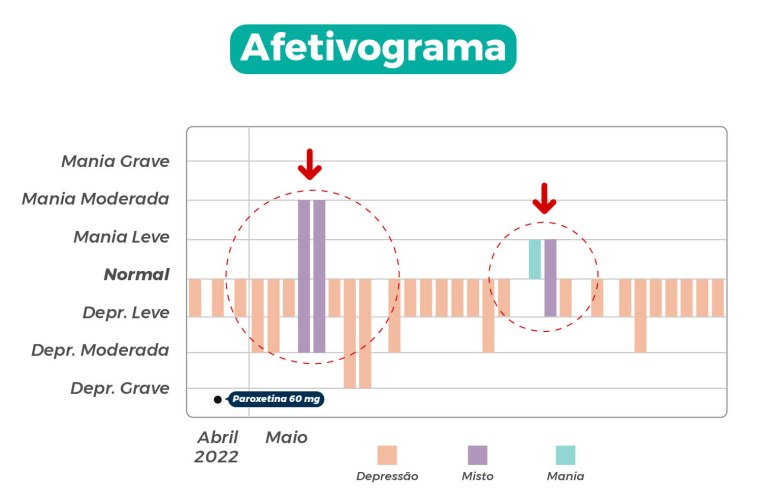
Examples
Moodr can be used to increase accuracy in diagnosing discrete cases of Bipolar Disorder or Cyclothymia in patients with depressive polarity. In other words, the app helps the healthcare professional and the patient to detect important symptoms and clarify the diagnosis and comorbidities. Clinical decision-making, medication adjustment, prognosis monitoring, relapse prediction, and self-knowledge are all improved.

Using MOODR for decision-making | Treatment of Bipolar Disorder

Using MOODR to identify comorbidities | Treatment of Bipolar Disorder

Using MOODR for differential diagnosis | Treatment-Resistant Depression
See below some examples of the app’s clinical uses

Juliana
Click on the image to view it in high-definition
Juliana, 40 years old, sought treatment due to her symptoms of chronic depression. Since the age of 20, she has been taking psychiatric medication but has always had a poor response to antidepressants. She had a family history of cyclothymia.
Juliana arrived for treatment using Paroxetine 60mg (first black dot in the image). It had several side effects, such as intense sweating, loss of libido, and mood swings. She was instructed to use Moodr. In the first few weeks, it was possible to observe mood swings and a day of hypomania (images).
Given these data, the hypothesis of bipolar II disorder was raised. Paroxetine was withdrawn, and Lamotrigine 25 mg was introduced with gradually increasing doses (black dots).
Using Moodr, it was possible to see that with low doses, Juliana still had moderate depressive symptoms, deciding to increase the dose in the subsequent appointment. At the same time, the medication was effective in reducing and preventing mood swings and hypomanic episodes.
In summary, Moodr helped to identify bipolar disorder, change medication, and monitor the patient's clinical evolution in more detail, resulting in better stabilization of the condition.

Matheus
Click on the image to view it in high-definition
Matheus, 53 years old, sought treatment due to his irritability problems, which were accompanied by depressive symptoms. The patient's mother was diagnosed with Type II Bipolar Disorder. Matheus was unsure whether he had the same diagnosis.
Thus, Moodr was used to monitor hypomanic, irritability, and anxiety symptoms. The patient was psychoeducated about the meaning of these symptoms and how to monitor them in the app.
Moodr was used for three months. Every time he was irritable, he added comments about his day (red dots). He was asked to speak about the comments recorded.
Through comments and daily monitoring, it can be seen that irritability was always associated with specific daily events, and not due to mood swings. No hypomania was identified. Thus, depression diagnosis and treatment were maintained.
In summary, using Moodr in the first months of treatment helped to improve diagnostic accuracy and promote greater self-knowledge by monitoring the triggers of his irritability.
Clinical uses
Detailed monitoring of the evolution of symptoms.
You will be able to view the improvement or worsening of your symptoms, which are recorded daily in the app. Then, you can see if the treatment is working.
Assistance in clinical decision-making.
By analyzing the Summary and the mood chart, the healthcare professional can maintain or change the treatment plan in order to make the best therapeutic decision for the case.
Recording changes in medications over time.
Whenever a change occurs, whether adding or removing medication or changing the dose, this will appear as a black dot on the mood chart. This way, it is easy to see which therapeutic changes were made and how they impacted the evolution of symptoms.
Identification of comorbidities.
Comorbidity is the presence of more than one disorder. By recording several symptoms in detail
it is possible to identify if other symptoms, in addition to the mood disorder
are present, which could change the patient's treatment and improve his/her quality of life.
Differential diagnosis
When there are doubts about the diagnosis, the health professional needs to collect information to make a differential diagnosis, that is, to distinguish whether the symptoms are from one disorder or another. For example, an important differential diagnosis is between bipolar disorder and depression. By monitoring symptoms in detail, the app can help to make this distinction and define the cause of the symptoms and their respective treatment.
Blog

Doctor, teach your patient, it's quick and easy
Check out tips for using Moodr and how to teach your patient how to use it.






